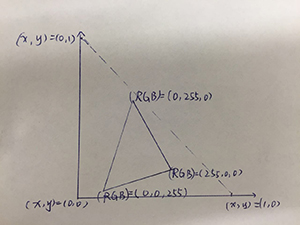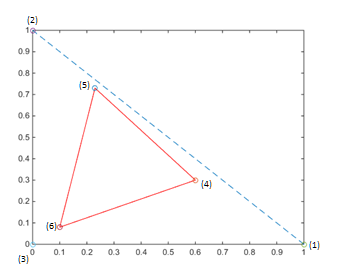Contents
ECE Ph.D. Qualifying Exam in Communication Networks Signal and Image processing (CS)
August 2015, Part 1
- Part 1 , 2
Solution 1
a) $ \gamma=1 $
b)
$ \left( \begin{array}{c} X_r\\ Y_r \\ Z_r \end{array} \right)= \left( \begin{array}{ccc} a & b & c \\ d & e & f \\ g & h & i \end{array} \right) \left( \begin{array}{c} 1 \\ 0 \\ 0 \end{array} \right)= \left( \begin{array}{c} a \\ d \\ g \end{array} \right) $
So
$ (x_r,y_r)=(\frac{X_r}{X_r+Y_r+Z_r}, \frac{Y_r}{X_r+Y_r+Z_r})=(\frac{a}{a+d+g},\frac{d}{a+d+g}) $
Similarly
$ (x_g,y_g)=(\frac{b}{b+e+h},\frac{e}{b+e+h}) $,
$ (x_b,y_b)=(\frac{c}{c+f+i},\frac{f}{c+f+i}) $
c) The white point of the device is when the input $ [R, G, B] = [1, 1, 1] $
$ (x_w,y_w)=(\frac{a+b+c}{a+b+c+d+e+f+g+h+i},\frac{d+e+f}{a+b+c+d+e+f+g+h+i}) $
e) We are likely to see quantization artifact in dark region.
Solution 2:
a) $ \frac{R}{255}^\alpha=r_{linear}\\ \Rightarrow \gamma=log_{\frac{R}{255}}{(R^{\alpha})}=\frac{ln{(R^{\alpha})}}{ln{\frac{R}{255}}}=\frac{\alpha{ln{R}}}{ln{R}-ln{255}} $
b)
$ P_r= \left( \begin{array}{ccc} a & b & c \\ d & e & f \\ g & h & i \end{array} \right) \left( \begin{array}{ccc} 1 \\ 0 \\ 0 \end{array} \right) = \left( \begin{array}{ccc} a \\ d \\ g \end{array} \right) \\ \Rightarrow x_r=\frac{a}{a+d+g} , y_r=\frac{d}{a+d+g} \\ P_g= \left( \begin{array}{ccc} a & b & c \\ d & e & f \\ g & h & i \end{array} \right) \left( \begin{array}{ccc} 0 \\ 1 \\ 0 \end{array} \right) = \left( \begin{array}{ccc} b \\ e \\ h \end{array} \right) \\ \Rightarrow x_g=\frac{b}{b+e+h} , y_g=\frac{e}{b+e+h} \\ P_b= \left( \begin{array}{ccc} a & b & c \\ d & e & f \\ g & h & i \end{array} \right) \left( \begin{array}{ccc} 0 \\ 0 \\ 1\end{array} \right) = \left( \begin{array}{ccc} c \\ f \\ i \end{array} \right) \\ \Rightarrow x_g=\frac{c}{c+f+i} , y_g=\frac{f}{c+f+i} $
c)
$ W= \left( \begin{array}{ccc} a & b & c \\ d & e & f \\ g & h & i \end{array} \right) \left( \begin{array}{ccc} 1 \\ 1 \\ 1\end{array} \right) = \left( \begin{array}{ccc} a+b+c \\ d+e+f \\ g+h+i \end{array} \right) \\ \Rightarrow x_g=\frac{a+b+c}{a+b+c+d+e+f+g+h+i} , y_g=\frac{d+e+f}{a+b+c+d+e+f+g+h+i} $
e) Gamma correction an quantization will create an effect of dynamic range compression for pixels with small values. This will create dark block of shadings in a gradient region instead of a smooth transition.
Related Problem
Consider a color imaging device that takes input values of $ (r,g,b) $ and produces ouput $ (X,Y,Z) $ values given by
$ \left[ {\begin{array}{*{20}{c}} X\\ Y\\ Z \end{array}} \right] = \left[ {\begin{array}{*{20}{c}} a&b&c\\ d&e&f\\ g&h&i \end{array}} \right]\left[ {\begin{array}{*{20}{c}} r^\alpha\\ g^\alpha\\ b^\alpha \end{array}} \right] $
a) Calculate the white point of the device in chromaticity coordinates.
b) What are the primaries associated with the r,g, and b components respectively?
c) What is the gamma of the device?
d) Draw the region on the chromaticity diagram corresponding to $ r < 0, g > 0, b > 0 $.



